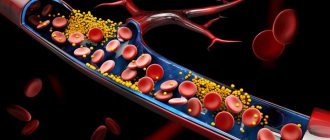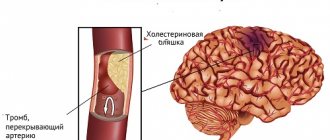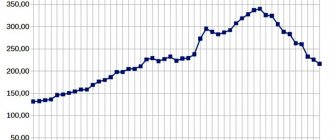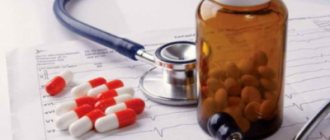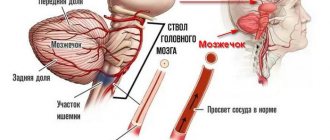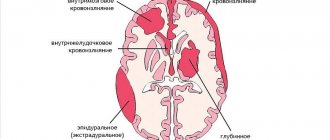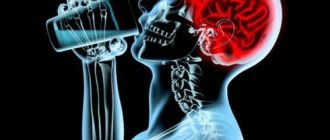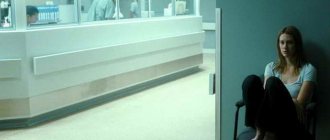Features of treatment
Lacunar cerebral infarct (LACI) is a disorder characterized by motor and sensory disturbances.
Occurs due to thrombosis or embolism of small cerebral arteries. Thrombosis occurs due to vascular atherosclerosis. An embolism is usually caused by the formation of a blood clot elsewhere in the vascular system (often in atrial fibrillation) and its penetration into the cerebral vessels. Lacunar cerebral infarction most often affects the mobility of various parts of the body, but early treatment (up to 3-6 hours after the onset of the attack) significantly increases the chances of completely curing the neurological consequences.
Features of lacunar cerebral infarction (stroke):
- possibility of unnoticeable manifestation - can only be detected on MRI;
- after the attack is completed, a cavity (lacuna) is formed;
- neurological manifestations are mild or transient (transient hemiparesis, hemihypesthesia, dysarthria, ataxia).
Complex treatment of lacunar stroke has the following goals:
- decreased blood pressure;
- restoration of normal nutrition of brain tissue;
- prevention of complicated situations (embolism, thrombosis).
This can be dealt with by competent and timely prescribed therapy, including:
- taking medications;
- rehabilitation;
- therapeutic nutrition.
Antihypertensive drugs are used to lower blood pressure:
- ACE inhibitors (lisinopril, enalapril);
- vasodilators (Diltiazem, Nifedipine);
- diuretics (Furosemide, Indapamide), etc.
To restore brain structures and improve microcirculation, Nootropil, Vinpocetine, Akatinol, B vitamins, etc. are prescribed. Antidepressants (Amitriptyline, Fluoxetine) are used to relieve depressive conditions. Statins are used to combat atherosclerosis and lower cholesterol. To prevent complications, the patient is prescribed Aspirin, which can thin the blood.
A rehabilitation program for patients who have suffered a lacunar stroke is necessary to restore motor and speech functions and lost sensitivity. It includes:
- physiotherapy;
- exercise therapy;
- massage;
- speech training, etc.
If all medical recommendations are followed, the prognosis is considered favorable.
Treatment
Therapy is strictly inpatient conditions. At least in the first few days. Until permanent correction of the condition. Drugs from a number of pharmaceutical groups are prescribed:
- Thrombolytics. In the first 4-8 hours from the onset of the pathological process. Fibrinolysin or streptokinase. Dissolves formed blood clots. Does not allow hemodynamic disorders to progress.
- Antiplatelet medications. Prevents further development of blood clots. Aspirin-Cardio or Heparin, other names are possible.
- Fast acting diuretics. For example, Furosemide or osmotic diuretics - Mannitol in limited quantities. Medicines prevent swelling of the brain and the possible fatal consequences of this emergency. They are not suitable for long-term use; they have a negative effect on the heart and blood vessels.
- Cerebrovascular medications. Normalizes brain nutrition. Piracetam or Actovegin. The course of therapy with these drugs is continued after the end of the acute period.
- Angioprotectors. Strengthen the walls of blood vessels and increase their elasticity. The names are selected by a specialist.
The following medications are also used:
- Antihypertensive. Reduce blood pressure. ACE inhibitors, calcium antagonists, beta blockers. Centrally acting medications. They are prescribed strictly by a doctor; usually a cardiologist is involved in the work to determine the safest combination. Resistant forms of hypertension are not controlled by monotherapy methods. A group of drugs is needed.
- Sedatives. Mild, tranquilizers can be used to reduce anxiety.
Pills alone will not be enough. A diet correction is required (treatment table No. 10), if possible, it is recommended to consult a nutritionist, quitting smoking, alcohol, especially psychoactive substances, drugs.
Physical activity is brought back to normal; it must be adequate to the level of human development, well below the potential limit. It is recommended to sleep at least 7 hours per night, avoid stress, and master relaxation techniques.
The rehabilitation period is 2-3 months. This is a record short time for a stroke. A positive feature is the possibility of complete recovery without neurological deficit even in the most complex clinical cases.
The components of this critical period:
- Use of medications. A triad of drug groups is used: cerebrovascular to stabilize cerebral blood flow, antihypertensive to lower blood pressure, angioprotectors to strengthen blood vessels.
- Physiotherapy. Patients who have had a lacunar stroke are rarely so severely ill that they cannot move. Active exercises are recommended, passive exercises are used in the first days to normalize trophism in paralyzed limbs. In this case, the movements are performed by an assistant.
- Massage. As part of the normalization of trophism of the arms and legs, restoration of peripheral blood flow.
Gradually, the patient should begin to walk on his own, first with the help of medical personnel, then without it.
The hospital period lasts about 1-2 weeks. A referral to a rehabilitation center is possible, this will take another 2-3 weeks. Then, with clear recommendations, the person goes to recover at home.
With a competent and responsible approach, following the advice of a specialist, there is every chance of full compensation for the violation.
What is lacunar ischemic stroke?
Gaps in brain tissue are like holes in cheese, but holes are formed from an abundance of fermentation gases, while lacunae are the result of a poor blood supply.
The central artery leading to the lacuna can be blocked by a microembolus or microthrombus against the background of damage to its walls by lipohyalinosis or atheromatosis, narrowing of the lumen and difficulty in the passage of blood through it.
As a result, small focal infarctions occur in the deep parts of the brain, and atrophy of the medulla ends with its resorption with the formation of microcavities filled with cerebrospinal fluid. Microinfarctions are caused by “fatigue” of the vascular walls as a result of atherosclerosis, diabetes mellitus, chronic diseases of the respiratory system and other conditions leading to loss tone and degeneration of the walls aa. perforans - small-caliber perforating arteries. The more lacunae in the medulla, the weaker its work and control over the activities of the body.
You may also be interested in an article on how to recognize a mini-stroke?
Causes and risk factors
Doctors often call a lacunar stroke a heart attack. The main cause of its occurrence is considered to be circulatory disorders in the deep perforated arteries of the brain against the background of hypertension and systemic atherosclerosis.
Small lacunae form in areas of cerebral tissue damaged by ischemia. The average diameter of such cavities is 10 mm.
Lacunar cerebral infarction is often visible in the tissues of the cerebellum, white matter, internal capsule, pons, and thalamus.
Factors contributing to the development of lacunar brain damage should be considered:
- poor nutrition;
- prolonged stressful situations;
- bad habits - smoking, alcohol abuse;
- elderly age;
- brain infections;
- long-term use of hormonal contraceptives;
- lack of proper rest and sleep, etc.
The most common causes of this disease are the following pathologies:
- hypertension with frequent crises, sudden changes in blood pressure, in the absence of treatment;
- atherosclerosis, leading to hardening of the blood vessels of the brain;
- diabetes mellitus with metabolic disorders;
- thromboembolism;
- vasculitis of an allergic or infectious nature, disrupting the normal movement of blood through the vessels of the brain;
- genetic changes in the anatomical structure of arteries;
- dissection of arterial walls;
- functional disruptions in the central artery;
- bleeding disorders;
- consequences of myocardial infarction, etc.
Important information: How to prevent recurrent ischemic stroke and its primary (secondary) prevention
A healthy lifestyle and caring attitude towards your health help reduce the risk of this type of stroke.
Causes
Any stroke, including lacunar, develops as a result of the following reasons:
- Atherosclerosis and thrombosis. These pathologies cause ischemia (lack of blood supply to the organ) due to blockage of the vessel by a blood clot or atherosclerotic plaque. The first signs of a stroke appear when the lumen of the vessel is blocked by more than 70%. With a lacunar stroke, collateral circulation (bypass as a method of compensation) does not have time to form.
- Cardiogenic embolism. It is the cause of 20% of all strokes. An embolism forms in the heart and its valves, which is a consequence of cardiac arrhythmia. Atrial fibrillation provokes a stroke in 4.5% of cases.
- Violation of hemodynamic properties, for example, with a sudden drop in blood pressure due to stenosis of the main arteries of the neck.
- Other diseases: Takayasu's disease (inflammation of the vascular walls and a decrease in their lumen), Moyamoya disease (the tendency of brain vessels to gradually narrow).
Systemic factors that increase the likelihood of developing a stroke:
- Arterial hypertension.
- Heart rhythm disturbance.
- Blood diseases: blood clotting disorders, increased number of red blood cells per liter of blood.
Any of these reasons triggers a chain of pathological mechanisms that lead to ischemia and necrosis of brain tissue. Normally, the volume of blood flow in the brain is 55-60 ml per 100 g of substance per minute. Thus, the first pathobiochemical reactions occur when blood circulation decreases to 50 ml per 100 g. The first reaction is that the production of proteins in brain cells is inhibited. The primary marginal ischemic zone is formed.
When the blood supply drops to 35 ml per 100 g, an alternative pathway for energy production is activated - glucose is broken down (glycolysis). As a result of the oxidation of glucose, molecules of pyruvic acid and two molecules of ATP (one of the energy sources) are formed. An alternative pathway is the anaerobic pathway, that is, energy is generated without the participation of oxygen reaction, since during ischemia there is little oxygen in the brain. Due to the anaerobic pathway for energy production, lactate accumulates.
Lactate (lactic acid) is a normal compound that appears, for example, in muscles after intense exercise. However, due to increased glycolysis, lactate becomes too much. Lactate itself is a breakdown product that needs to be disposed of. But in the ischemic zone there is a lot of it. The accumulation of lactate shifts the acid-base balance towards acidity (pH decreases). Local acidosis occurs, which is manifested by a typical clinical picture for such a condition.
When the volume of cerebral circulation decreases to 20-25 ml, the cortex, due to lack of oxygen and nutrients, is inhibited. Drowsiness, apathy and indifference occur. When the minute volume of blood flow drops to 10 ml, irreversible organic changes occur in the brain due to the death of neurons. During the first two days, alternative sources of nutrition support the weakened vital activity of the cell. However, after 48 hours the cell dies completely.
Possible consequences
Complications at the moment of the onset of the pathological process itself almost do not develop, which, on the one hand, facilitates the patient’s condition and the course of treatment, on the other, can send an inexperienced specialist on the wrong path.
The most obvious consequence of lacunar stroke is persistent neurological deficit after rehabilitation. Usually not of a cognitive, but of a motor nature: motor dysfunctions. But this is a relatively rare occurrence.
Vascular problems develop latently. Arteries are rarely destroyed. More often than not, some blood flow is maintained. The pressure increases, the wall becomes thinner and weakens.
Aneurysms develop - sac-like protrusions. Rarely single, more often a group of vessels is involved in the process at once. At a certain point, a rupture occurs and blood flows into the brain space.
This ends with a hemorrhagic lacunar stroke, which is many times more severe and leads to severe disability and defects. Prevention of life-threatening and health-threatening complications is part of the treatment.
Aneurysms of lacunar vessels are extremely difficult to determine, but they do not form overnight. It takes time. Therefore, doctors prescribe cerebroprotectors, drugs to increase vascular elasticity, and antihypertensives. This is, among other things, a measure to prevent unobvious results.
Stroke in cerebral lacunae is a rare and relatively mild form of cerebrovascular insufficiency. Therapy is carried out in a hospital. There are still risks, but the prospects for a complete cure are almost maximum.
Diagnosis of ischemic stroke
Timely diagnosis allows you to begin adequate therapy. It should be aimed at establishing the type of stroke, differentiating ischemia and hemorrhage.
Doppler ultrasound of head and neck vessels
Duplex scanning of the carotid arteries is necessary for all patients with stroke. Doppler ultrasound determines the causes of ischemia, as well as the need for surgical intervention. The scan reveals the degree of carotid artery stenosis.
Computed tomography of the brain
Computed tomography confirms the diagnosis of ischemic stroke. Sometimes supplemented by lumbar puncture to exclude meningitis or subarachnoid hemorrhage. The combination of CT and angiography determines vascular occlusions and tissue areas with restored blood flow.
CT picture of ischemic stroke in the right hemisphere. Picture of ischemic stroke. Ischemic stroke in the right hemisphere.
MRI of the brain
MRI is a highly sensitive method for detecting acute intracranial hemorrhage. Imaging provides structural detail of the affected area and reveals early cerebral edema. However, CT is considered a more accessible option for emergency diagnosis.
Therapy for circulatory disorders
Treatment of lacunar stroke itself depends on its type. In case of ischemia, that is, blockage by a blood clot, antiplatelet agents (prevent platelet aggregation and the formation of a blood clot) and anticoagulants (prevent the formation of clotting factors - proteins that thicken the blood) are used. The main antiplatelet agent is acetylsalicylic acid, the anticoagulant is heparin, warfarin.
For hemorrhagic stroke, therapy is aimed at stopping bleeding into the brain parenchyma from a ruptured vessel. For this purpose, a fibrinolysis inhibitor is used - alpha-aminocaproic acid.
Sometimes, if significant arterial stenosis (more than 80%) and a large area of necrosis is detected, neurosurgical intervention is indicated. But surgery is very rare in patients with lacunar infarction.
How long do you live after an ischemic stroke?
The prognosis for life after an ischemic stroke is of 3 types:
Favorable. It is placed when the brain damage is minor. The duration of the recovery period is reduced to several months. The person completely returns to normal life.
Average. Such prognoses for life are given if the functioning of the gastrointestinal tract is disrupted, the patient suffers from diabetes, pneumonia or other diseases of the internal organs. Complications are of moderate severity.
Adverse. Placed in cases of extensive brain damage. Here the functioning of vital organs, in particular the heart, is usually disrupted. The chances of survival are minimal. Most often, this prognosis is given for left-sided stroke.
According to statistics, 12-25% of victims die from the consequences of a cerebral infarction in the first week. Of those who survive, 70% become disabled. However, over time, the severity of complications decreases. After six months they persist in 40% of patients, and after a year only in 25%.
The effectiveness of the rehabilitation period, life expectancy and prognosis for the future depend on several factors:
- Age. In elderly patients, even after a moderate stroke, recovery is more difficult than in younger people.
- Size and location of the affected area. If the areas of the brain responsible for the work of the most important centers are damaged, the risk of death increases greatly.
- Severity of damage. The more severe the pathology, the more difficult it will be for the body to recover.
- Cause. If the cause of an ischemic stroke is atherosclerosis or thrombosis, recovery will be much more difficult.
Among the consequences of ischemic cerebral stroke, several conditions stand out:
Mental disorders. Many find it difficult to realize their incapacity. The patient is afraid of becoming a burden to family and friends, which is why he develops depression. He experiences bouts of uncontrollable aggression. He becomes nervous and irritable. There are also frequent mood swings.
Lack of sensitivity in the face, arms and legs. The numbness goes away gradually because the nerve fibers are restored very slowly. In some cases, sensitivity does not return completely.
Impaired mobility. The victim is often unable to walk without special aids, such as a cane or walker. Sometimes it is difficult for him to do some simple things. Fine motor skills are impaired.
Cognitive impairment. First of all, they concern memory. A person forgets not only addresses and phone numbers. Sometimes he cannot remember the person with whom he had a dialogue a minute ago. It is also difficult for the patient to correctly assess what is happening around him. Therefore, in behavior he can resemble a child.
Speech problems. It becomes incoherent and meaningless. Often the victim utters some incomprehensible words and phrases.
Impaired coordination of movements. Due to frequent dizziness, a person falls.
Epilepsy. More than 10% of patients who have experienced ischemic stroke suffer from this disease.
How many years can a person live after a cerebral infarction? It all depends on how timely the assistance was provided. The sooner doctors begin treatment, the less dangerous the consequences will be.
Therapy must be comprehensive and carried out in a hospital. How long do you stay in hospital after a stroke? After the acute period ends, the patient is transferred to the general ward, where he will stay from 3 weeks to a month. If the functioning of vital organs is not impaired, the course of treatment is 21 days.
If the functioning of vital organs is disrupted, the patient must remain in the hospital for approximately 30 days. If there is no improvement, doctors hold a consultation at which they decide on his further stay in the hospital until his condition improves.
So, ischemic stroke is the most common pathology of the cardiovascular system. It's sad, but every year she gets younger. And if earlier stroke occurred mainly in older people, today even younger people face it. To protect yourself from it, you need to take your health seriously. You need to change your diet, give up bad habits and add moderate physical activity. If the slightest alarming symptoms appear, you should immediately consult a doctor.
Why is this type of stroke dangerous?
If lacunar ischemic stroke of the brain has a single small lesion and occurs for the first time, then the risk of complications is small. With timely treatment and proper rehabilitation, the patient returns to a full life.
With focal multiplicity of stroke, there can be severe consequences, most of all affecting the patient’s psyche. These include:
- partial or complete memory loss;
- spatial disorientation;
- decreased mental and speech abilities;
- motor impairment;
- difficulties in communication;
- tearfulness, irritability, hysteria, etc.
Every third patient is diagnosed with parkinsonism after a year, and subsequently with vascular dementia. Lack of proper treatment for lacunar stroke can be fatal.
Diagnostics
The pathology is diagnosed using the criteria for lacunar stroke, objective examination and instrumental research methods.
Criteria for lacunar stroke:
- The clinical picture does not show a violation of cortical functions, but there is one of the five above-mentioned syndromes.
- The presence of diabetes mellitus or arterial hypertension has been established.
- Magnetic resonance imaging reveals a lesion measuring 1.5 cm.
Objective examination: a neurologist determines sensory disturbances, decreased muscle strength, impaired consciousness or impaired coordination.
Principles of treatment of lacunar stroke:
- Basic therapy: first aid, resuscitation measures (removal of cerebral edema, protection of cells from hypoxia, control of blood pressure, respiratory support).
- Specific therapy: maintaining metabolism in neurons and restoring blood circulation.
- Thrombolytic therapy (drugs that dissolve blood clots).
- Anticoagulants (drugs that prevent blood clots from forming).
- Restoration of hemodynamic properties of blood.
The life prognosis depends on the size of the stroke focus and complications (cerebral edema, pneumonia, old age). Statistically, 20% of patients die in the first month after a stroke. Patients die not from damage to brain tissue, but from complications, most often as a result of dislocation syndrome or cerebral edema. The remaining patients (80%) become disabled. The first signs of recovery in survivors appear 3 months after the stroke.
Lacunar cerebral infarction: what is it?
This is one of the types of stroke, that is, an acute circulatory disorder in the brain, which is characterized by the presence of small foci of death of brain tissue (necrosis), located deep in the tissues of the cerebral hemispheres or the brain stem. This size of necrosis is determined by the small diameter of the vessels, blocked by a thrombus or embolus (in an ischemic stroke) or damaged by a rupture of a thinned wall (in a hemorrhagic stroke). Most often, it is lacunar ischemic infarction that occurs, rather than hemorrhagic.
Since the diameter of the damaged vessels is insignificant, changes in the brain are often discovered by chance, during examination for other diseases. If the area of necrosis has a small diameter, then even modern magnetic resonance imaging is unable to visualize it. Necrosis larger than 20 mm is extremely rare and is called giant necrosis.
Symptoms
The main feature of lacunar stroke is its manifestation. With this pathology, any disturbances associated with consciousness, vision or speech are almost always absent. At the same time, the brain functions in its usual way, and there are no signs of damage to its trunk. The only obligatory symptom is a persistent increase in blood pressure. In most cases, it reaches its maximum values in the late evening, after which it returns to the patient’s usual level.
All the main symptoms of lacunar stroke that a person may experience are neurological. They manifest themselves in the form of specific syndromes. Their total number reaches 20 species, but only 4 of them are recorded with sufficient frequency. They differ not only in manifestation, but also in localization of disorders. These syndromes include:
- Isolated motor. It is observed in 60% of patients experiencing lacunar stroke. The pathology is concentrated in the internal capsule. Symptoms consist only of paralysis of one half of the body, which is opposite to the side where the disorders are localized.
- Isolated sensitive. About 20% of patients who have lacunar-type circulatory disorders encounter this syndrome. The localization of the problem focus is the ventral thalamic ganglion. The patient experiences problems with sensitivity, due to which he ceases to feel movements, does not feel pain, touch or changes in body temperature. All this manifests itself in the limbs, torso and head. Sometimes symptoms go away without medical intervention.
- Atactic hemiparesis. Occurs in 12% of cases, which makes it quite rare. Lacunae with this pathology are formed in the dorsal part of the internal capsule, as well as in the pons. The patient experiences severe weakness, as well as impaired coordination of movements, which manifest themselves on the left or right parts of the body, which corresponds to the side where the lesion is localized.
- Hand clumsiness, dysarthria. Only 6% of patients may encounter this, making this problem one of the least likely. Lacunae with such a stroke appear in the layers of nerve tissue. For this reason, a person experiences disorders that cause problems with speech or movement of the upper limbs, as well as complete or partial paralysis of the head, arms and legs.
If such symptoms appear that do not affect consciousness and brain activity, you should immediately consult a doctor or call an ambulance. Timely medical assistance can save a person’s life, but delay will seriously increase the likelihood of death.
Additional signs indicating a lacunar infarction may include:
- Biliary dyskinesia;
- Pseudobulbar palsy;
- Parkinsonism syndrome;
- Decreased sensitivity of body parts;
- General muscle weakness;
- Change in gait, short step;
- Sudden urge to urinate, incontinence.
Other symptoms occur extremely rarely, which is why it can be argued that they are caused by specific conditions relating to the circumstances of the stroke and the general health of the patient.
Clinical picture of the disease
In most cases, the attack can be sudden, very quickly leading to blockage of the arteries, but it can last up to five days. Precursors may include ischemic attacks that cause disruption of cerebral circulation in small cerebral arteries.
During an attack, you may experience high blood pressure and an irregular heart rhythm. Single cysts - lacunae do not lead to paralysis of the body. Detection of the lacunar form of cerebral infarction is complicated by the implicit manifestation of symptoms:
- Impaired motor skills are expressed in the inability to move the limbs; they become less sensitive.
- Loss of coordination. The patient may complain that everything is floating before his eyes, there is an unsteady gait and disorientation.
- The lacunar form of the disease is characterized by neurological disorders, expressed in the deterioration of memory, the ability to analyze, there is no logic of reasoning, and other processes of the brain are disrupted.
To immediately contact a doctor, one of the following symptoms of a stroke is sufficient:
- A sharp manifestation of weakness in the legs, fainting, loss of consciousness;
- Distortion of the face, numbness of half the body, limbs, impaired skin sensitivity;
- Difficulty in speech and impairment of its perception;
- The patient begins to feel dizzy and finds it difficult to maintain coordination of movements;
- Severe pain in the head appears;
- Cramps, increased muscle tone.
The severity of the damage depends on the size of the part of the brain affected by the stroke. Symptoms of the disease may appear during sleep and not be accompanied by loss of consciousness. Unlike extensive cerebral hemorrhages, the lacunar form is not accompanied by loss of vision. The prognosis of this disease is the most favorable compared to other forms of cancer.
Treatment tactics
For adequate therapy and in the future for the purpose of preventing recurrent cerebrovascular accidents, patients are prescribed aspirin to reduce the aggregation of blood elements (sticking together and forming blood clots) and improve its fluidity. The most acceptable dose is considered to be 75 mg of acetylsalicylic acid, produced specifically for these purposes.
If it is impossible to take aspirin due to intolerance or side effects, it is possible to replace it with dipyridamole at a dose of 200 mg daily or 75 mg of clopidogrel. Dosages are specified and regulated by specialized specialists.
Normalization of blood circulation is achieved by prescribing drugs that improve microcirculation. The optimal choice is nicergoline, vinpocetine, pentoxifylline. First, a course of intravenous drips is carried out, followed by a transition to long-term use of tablet forms.
At the same time, neurotrophics are recommended - medications that optimize the supply of oxygen to the brain and stimulate recovery. These are Cerebrolysin, Actovegin, citicoline and ginkgo biloba preparations (memantine, tanakan, bilobil).
With the development of signs of dementia and the formation of a lacunar state, anticholinesterase drugs and precursors of acetylcholine, a biologically active substance involved in the conduction of impulses along nerve trunks, are prescribed. These are prozerin, neuromidin, galantamine in the required dosages.
With parkinsonism, the patient needs to take specific drugs to reduce tremors (cyclodol, amantadine).
To restore mental abilities and reduce the manifestations of dementia, it is necessary to use the patient’s intelligence as much as possible, forcing him to memorize poems, allowing him to solve simple mathematical problems.
Since the leading cause is hypertension, its adequate reduction can be considered as one of the links in the treatment process. The therapist and cardiologist select an adequate dose and combination of drugs. When prescribing a correction regimen, the patient’s age and the presence of significant concomitant diseases are taken into account: diabetes mellitus, chronic kidney disease.
Diagnosis of cerebral infarction
The doctor may suspect a lacunar cerebral infarction based on the patient’s complaints. But a complete picture of the disease can only be obtained using the following research methods:
- First of all, this is computed tomography, which allows you to obtain a virtual multi-level slice of the brain;
- General laboratory analysis of blood and urine, as well as analysis of blood biochemistry, the presence of glucose in it, determination of cholesterol levels, coagulation indicators;
- ECG to detect heart rhythm disturbances;
- Ultrasound duplex scanning allows you to analyze the condition of the vessel walls, the presence of cholesterol plaques on them, and congenital defects.
Symptoms
Lacunar stroke occurs without the clinical manifestations of a traditional stroke; a microstroke is often diagnosed. Speech does not undergo changes, there is no impairment of consciousness. There are no age restrictions. There are known cases of a young man suffering a micro-stroke at an age not exceeding 25 years.
Knowledge of the features of clinical manifestations of pathology can save the patient’s life:
- Hypertension for several hours may be accompanied by unbearable pain radiating to the head.
- Gradual deterioration in health, unexpected imbalance, appearance of neural symptoms.
- Unreasonably slow gait.
- Involuntary urination and diarrhea may occur during sleep.
- Rarely, loss of sensation in a part of the body and speech impairment occur.
After a micro-stroke, all damaged functions of the body are restored, which instills in the patient the idea of a past mild illness; he continues to live and work in the same rhythm. The forecasts in this case are disappointing. Complications will not take long to appear.
Doctors identify in patients many syndromes observed during lacunar cerebral infarction:
- An isolated motor variant is diagnosed in 60% of patients. The patient's half of the body, sometimes the face, is paralyzed. Lacunar lesions form near the internal capsule of the brain. Plegia occurs on the side opposite to the formed lacuna. There are no other neurological symptoms.
- The isolated sensitive variant is diagnosed in 20% of patients. All kinds of sensitivity are impaired: tactile, muscle, temperature. The disease affects the entire human body. After a while, all sensory organs and motor systems are restored.
- Atactic hemiplegia is diagnosed in 12% of patients. Muscular hypotonia of the legs occurs, and a person’s coordination in space is impaired.
- Impaired hand coordination during movement occurs in 6% of patients. Speech is impaired, and paralysis of the head and limbs on one side gradually develops.
Classification
This cerebrovascular accident is divided depending on the vessels in which blood supply to the brain the catastrophe occurred. There are two vascular beds: carotid and vertebrobasilar. Thus, there are two types of cerebral infarction:
- lacunar infarction in the area of basal structures - occurs when blood flow in the vertebrobasilar region is disrupted;
- infarction in the cerebral hemispheres - appears when the carotid circulation is impaired.
Prevention
Lacunar ischemic stroke is a disease that mostly affects older people. Statistics are misleading and more and more young people are being affected. The reasons for the rejuvenation of the disease lie in the increasingly accelerating pace of life, increasing causes of stress, and bad habits. Having suffered a stroke, a person does not change his life and does not listen to the signals that the body sends. Lack of attention to yourself leads to irreversible consequences. For preventive purposes you should:
Use regular aspirin. It prevents vascular infarction. Attending physicians recommend that patients take soluble aspirin after discharge from the hospital. Take inventory of your menu. It is required to completely eliminate fast food and everything connected with it. Limit salt intake. After illness, it is strictly forbidden to use cholesterol- and sugar-containing foods in the diet. Closely monitor the dynamics of blood pressure values. Create a special notebook for daily recording of indicators and do not allow it to increase critically. Stop drinking alcohol and quit smoking. Do physical exercise, take walks in the fresh air. Monitor your body weight. After a myocardial infarction, it is necessary to undergo a recovery course. As prescribed by your doctor, take medications that prevent the formation of blood clots
Pay attention to the prothrombin index. If you suspect a stroke, immediately call a doctor and talk about how you are feeling. The consequences of an untreated disease will not allow the patient to lead a full life.
The lifestyle must be transferred to a calm, measured direction. Try to avoid unnecessary stress, heavy physical exercise, and forget about overwork. For those at risk, set a rule: undergo an MRI annually. Monitor the dynamics of the disease and, based on the results, make adjustments to therapy with the attending physician.
People around the patient should show patience and understanding. It must be remembered that after the development of lacunar syndromes ends, brain functions are restored. The period of recovery and return to a full life of a person who has suffered a lacunar stroke depends on a friendly attitude, sensitivity and attentiveness to the victim. First aid in case of recurrence should be provided by them.
Forecast
The prognosis for the development of lacunar stroke with timely diagnosis is favorable, characterized by rapid and complete recovery. However, recurrent strokes and the presence of multiple lesions reduce the chances of full recovery.
There is evidence that 10 years after a lacunar stroke, only 30% of patients remain alive, many of whom show signs of vascular dementia.
Many are also interested in the question: is it possible to work with lacunar cerebral infarction? During treatment and the rehabilitation period, it is worth avoiding increased mental and physical stress, as this can lead to a recurrence of a heart attack or the development of further adverse consequences (dementia, mental disorders).
We can conclude that such a seemingly insignificant pathology as lacunar stroke can lead to irreversible consequences in the absence of timely diagnosis and treatment. Therefore, this pathology should receive special attention from neurologists and radiation diagnosticians, and a person who feels the symptoms listed above should not delay, but immediately seek qualified help. After all, our health is in our hands!
Main reasons
The occurrence of a stroke is always associated with arterial hypertension. Chronic exposure to high blood pressure causes various pinpoint damage to cerebral vessels, up to 1 cm in length:
- death of artery wall cells, leakage of fibrin into the affected area (fibrinoid necrosis);
- release of plasma from the bloodstream (plasmorrhagia);
- impregnation of the vessel wall with a specific protein, making it look like a glass tube (hyalinosis);
- replacement of the artery wall with connective tissue;
- fat deposition, usually without the formation of atherosclerotic plaques.
The nerve cells located around the affected artery begin to receive an inadequate amount of oxygen and nutrients. When their deficiency becomes critical, neurons die. Over time, a lacuna forms at the site of necrosis.
Another mechanism for the formation of cavities is typical for infarctions located at some distance along the main vessel. The middle layer of the artery consists of muscle cells - myocytes, which are destroyed under the influence of arterial hypertension. The vessel ceases to cope with pumping blood, its distant branches remain half-empty, which leads to necrosis of neurons.
Rarely, the death of neurons to form lacunae is caused by the rupture of tiny protrusions of brain vessels (aneurysms). This form of the disease belongs to the hemorrhagic subtypes of cerebrovascular accident.
Previously, it was believed that arterial hypertension was the only cause of lacunar stroke. More thorough studies have shown that in some patients, cerebral infarction develops as a consequence of a combination of atherosclerosis of the cerebral arteries and high blood pressure. But atherosclerotic lesions of the arteries themselves, which supply the brain, extremely rarely cause the formation of cavities.
Other risk factors for lacunar stroke (3):
- type 2 diabetes mellitus;
- alcohol abuse;
- smoking;
- suffered micro-strokes;
- elderly age.
Consequences of the disease
Since lacunar stroke is characterized by its, in most cases, asymptomatic course, its diagnosis, and therefore timely treatment, is often difficult, which leads to the development of complications. Among the main consequences of lacunar cerebral infarction, there are both those that occur in the short term after the heart attack (the first six months) and more distant consequences.
In the first six months, progression of vascular disorders may occur with the development of more severe strokes and repeated lacunar strokes.
Among the more long-term consequences that develop several years after an episode of lacunar stroke, the most common are vascular dementia, that is, dementia, and mental health problems. This is manifested by sudden mood swings, changes in behavior, up to the complete impossibility of self-care.
The main outcome of lacunar infarction, which does not pose a danger, is the formation of a brain cyst. This is a round cavity filled with liquid. It is its visualization on MRI that confirms a lacunar stroke suffered in the past.
Symptoms of lacunar stroke
In most cases, the lacunar form of the lesion occurs as cerebral ischemia with a transient attack, like a microstroke, but the course may not be accompanied by symptoms. Features of the pathology:
- history of complicated and prolonged course of hypertension;
- the patient does not lose consciousness;
- focal symptoms increase over several hours or days, mainly during sleep;
- prognosis – satisfactory, with maximum possibilities for restoration of brain functions;
- angiographic examination does not reveal pathological changes;
- according to CT and MRI data - the presence of small, loose, round-shaped foci in the structures, or the absence of changes.
There are several variants of the course of lacunar stroke; they are also distinguished by the localization of lesions in the brain:
- Isolated motor form - the formation of lacunar cavities in the body of the bridge and the posterior part of the thigh of the internal capsule. The patient's symptoms include paralysis of one side of the body opposite the lesion.
- Isolated sensitive form - the ventral thalamic ganglion is affected. It manifests itself as a violation of the patient’s sensory functions (sensory syndrome).
- Atactic hemiparesis - the dorsal part of the internal capsule and the Varoliev bridge are affected. The patient has ataxia localized on the side of the injury, weakness of the muscles of the arm or leg, and pyramidal disorders.
- Dysarthria and dysfunction of one hand - occurs when lacunae form in the basal cells of the bridge. The patient has speech impairment of the dysarthric type, clumsiness of the hand develops, and paralysis in the muscles of the upper and lower extremities or head is possible.
Other symptoms:
- body movements performed involuntarily and obsessively (hyperkinesis) - tremors of the limbs, twitching of the shoulders and head, impaired muscle tone;
- parkinsonism syndrome;
- walking with small steps, staggering, lack of coordination;
- pseudobulbar syndrome;
- tendency to fecal and urinary incontinence;
- memory impairment.
Most often, a lacunar stroke occurs during sleep, the patient lies down feeling a headache and general malaise, and in the morning symptoms of the pathology appear. If the lacuna has formed in the “silent” zone, then there may be no clinical manifestations.
If a patient with lacunar ischemia works, then symptoms may manifest as difficulty concentrating on performing duties, lethargy, and slow processes of memorization and thinking. Sometimes the patient experiences difficulties with writing and perceiving new information.
The mild, and sometimes asymptomatic, course of the lacunar form of stroke gives the patient a chance to quickly recover from the injuries received. On the other hand, an asymptomatic course becomes the reason for therapeutic assistance not provided in a timely manner, which in the future can lead to relapses of the disease in more severe forms, which are accompanied by severe neurological deficits.
If no significant stroke symptoms were observed, subsequent examinations may reveal round cavities filled with cerebrospinal fluid in the brain structures. These formations have the nature of cysts and do not threaten the patient’s life, do not cause neurological disorders, but indicate that the patient has suffered a lacunar stroke.
Formations can be noticeable within a week after lacunar brain damage.
Lacunar cerebral infarction: causes, symptoms and treatment features
Health June 29, 2018
For many people, the word “stroke” or “cerebral infarction” is associated with vivid symptoms and severe, often irreversible, consequences.
However, there are also disturbances in the flow of blood in the brain that do not result in paralysis or speech impairment, symptoms characteristic of a stroke. Such circulatory disorders include lacunar infarction.
But it should be noted that even an asymptomatic stroke can be insidious and lead to serious consequences.
Causes
The reasons for the development of strokes, including lacunar strokes, are very individual. A pathology that causes lacunar cerebral infarction in one person may never cause such problems in another. However, you need to know that the risk factors for stroke listed below require consultation with a doctor in order to correct them and prevent the development of severe consequences. The main causes of lacunar infarction include:
- high blood pressure (hypertension);
- excessive body weight;
- atherosclerosis - increased cholesterol levels with the deposition of fatty plaques on the vessel wall;
- vasculitis - inflammation of the wall of blood vessels;
- diabetes;
- heart rhythm disturbances (arrhythmias);
- cardiac ischemia.
Diagnostic methods
To identify this disease, the presence of:
- arterial hypertension;
- heart rhythm disturbances;
- diabetes mellitus;
- dyscirculatory encephalopathy;
- ischemic attacks;
- mild or moderate focal neurological impairment;
- microangiopathy of the fundus vessels - narrowing of arterioles and expansion of the central vein.
To see the focus of destruction of brain tissue, you need to perform an MRI or, but with a cavity diameter of 1 - 5 mm, its detection presents significant difficulties. In such cases, only clinical manifestations are taken into account, which is also not always sufficient.
Prognosis and prevention
The role of aspirin and other blood thinning drugs was mentioned above. However, without lifestyle correction, changes in habitual attitudes regarding nutrition and bad habits , it is impossible to successfully combat the consequences of lacunar infarction, prevent lacunar condition and vascular dementia.
What is meant by this:
- Increase physical activity, reduce foods containing cholesterol in the diet.
- Quitting smoking and alcohol abuse . A glass of dry red wine is allowed in the absence of other contraindications.
- Compliance with absolutely all recommendations for the treatment of arterial hypertension and diabetes.
- Detection of signs of atherosclerotic lesions during duplex ultrasound scanning, high levels of “bad” cholesterol and lipoproteins – indications for prescribing a cholesterol-lowering diet and cholesterol-lowering drugs.
These medications are taken for a long time, under the control of a biochemical blood test due to their hepatotoxicity. If there is severe, more than 70%, stenosis of the main arteries, consultation with a vascular surgeon is recommended.
- If the risk of embolism is high , adequate treatment of arrhythmia and the prescription of powerful blood thinners are indicated. It is strictly not recommended to self-medicate, as these medications, if not prescribed correctly, can cause fatal bleeding.
The prognosis depends on discipline on the part of the patient and his relatives , who should be interested in recovery and preventing the development of intellectual disorders in the patient.
